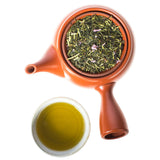A young monk came to the wise tea master Lao Cha and found him in a blissful state. So he asked:
– Sensei, what made you so happy and relaxed?
– Oh, young man, I just had a cup of Sakura Sencha. What a delight it was, what bliss! I couldn't help but reminisce on the days of sitting in Izu's cool breeze, with the sakura petals dancing around me.
This tea is a blend of sencha, produced on a family tea garden in Shizuoka, Japan, and sakura leaves from Izu. The tea does a great job of capturing the essence of Spring: the taste is light and refreshing. Smell it, and you will be greeted by a sweet, enjoyable aroma of cherry blossom and green tea. Brew it, take a sip, and be rewarded with an exquisite taste.
Our Sakura Sencha contains both flowers and leaves of the Sakura tree, enhancing its characteristic flavor, adding to the aroma, and making it visually pleasing. The subtle sweetness of cherry leaves and blossoms perfectly matches sencha's brisk taste. It also reminds of Sakura Mochi, a delightful springtime treat that serves as a "tea food".
The celebration of the Sakura blooming season is a long-time tradition in Japan, dating back to the Nara period (710-794). It marks the start of the planting season and turns into a symbol of hope, life, and a new beginning. When the time comes for the blossoms to open, people visit parks with sakura trees, contemplating the fleeting beauty of the blossoming petals.
Shizuoka is Japan's largest tea-producing region, and it accounts for roughly a third of Japan's total tea production. Shizuoka has a rich tea history, with a tradition of growing tea that dates back over 800 years. It is one of the original places where tea seeds were brought from China by the Zen Buddhist monk Eisai. Many mountainous areas dot Shizuoka's landscape. The volcanic soil is rich in nutritional substances and trace minerals. They get sucked in by the roots of the tea plant and create the unique flavor profile of this specialty tea.
You can enjoy our Sakura Sencha Green Tea, both hot and cold, and it is an excellent complement to desserts!
Brewing guidelines:
![]() 165℉ / 75℃ for the first infusion; Keep raising water temperature for subsequent infusions
165℉ / 75℃ for the first infusion; Keep raising water temperature for subsequent infusions
![]() 1g per 60ml
1g per 60ml
![]() 1-2min for the first infusion; then 30sec; +15 for each subsequent infusion
1-2min for the first infusion; then 30sec; +15 for each subsequent infusion



